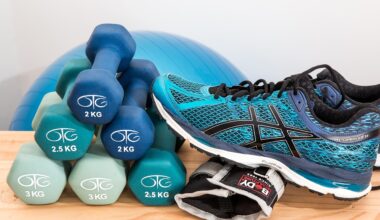Swimming for Rehabilitation: Helping Disabled Kids Recover Mobility
Swimming is an essential activity that offers numerous benefits for children with disabilities. It serves as an effective therapy option, promoting physical rehabilitation and enhancing overall mobility. The buoyancy of water provides a supportive environment, easing movements and allowing kids to explore without gravity’s constraints. Through regular swimming sessions, children can improve their muscle strength and coordination, critical factors in their rehabilitation process. Furthermore, the warm water in therapeutic pools can enhance circulation and relieve discomfort associated with certain disabilities. Engaging in swimming can also bolster confidence and self-esteem. As children learn new skills in the water, they become more capable, translating to empowered interactions in their daily lives. Additionally, swimming fosters social connections, providing opportunities to interact with peers and develop friendships. Many programs are specifically designed for children with disabilities, ensuring a safe and comfortable environment. These initiatives often involve trained professionals who understand the unique challenges facing these children. Ultimately, swimming is about more than just physical activity; it’s a holistic approach to improving the quality of life for disabled kids. By integrating fun with rehabilitation, swimming can fundamentally transform their experiences.
The Therapeutic Benefits of Water Activities
Water activities are particularly beneficial for enhancing mobility in children with disabilities. The resistance of water works effectively to strengthen muscles while reducing the risk of injury associated with traditional exercise. Each movement in the water requires more effort, promoting muscle engagement without overwhelming the child. This resistance helps create a fun and dynamic workout experience, motivating children to remain active as they recover. Beyond physical benefits, water activities serve as a wonderful outlet for emotional expression. The soothing nature of water has been shown to calm anxiety and elevate mood. In a supportive aquatic environment, kids feel more empowered to take risks and gain independence. Furthermore, swimming promotes cardiovascular health, contributing to overall fitness. As children engage in regular aquatic activities, they may experience improvements in endurance and energy levels, assisting with their everyday tasks. Social interactions during swimming sessions also cultivate teamwork and communication skills, essential for building friendships. Some programs even include competitions designed for children with disabilities, further inspiring participation. By incorporating both fun and exercise, the combination of therapeutic benefits found in swimming provides children with valuable tools for recovery and empowerment. Ultimately, each splash can represent a step toward progress.
While swimming provides significant physical benefits, it also helps develop life skills essential for children with disabilities. These skills contribute not only to their physical rehabilitation but to their overall growth and independence. Learning to swim fosters problem-solving abilities as children must navigate challenges, such as overcoming fear and understanding buoyancy. Each child progresses at their own pace, which encourages patience and resilience during the learning process. Furthermore, swimming lessons often teach personal safety, crucial for ensuring kids can handle themselves in and around water, promoting both fun and security. Setting personal goals related to swimming helps build motivation and focus, guiding them toward tangible achievements. For many children, reaching milestones, such as swimming a certain distance or performing a specific stroke, instills feelings of accomplishment that transcend the pool. Ultimately, the lessons learned extend beyond the aquatic environment, translating into everyday life. The sense of discipline and commitment developed can aid children’s participation in various activities. Parents and caregivers often witness significant positive changes in their children’s attitudes and self-perceptions when involved in swimming programs designed for their unique needs.
In addition to the physical and emotional benefits, participation in swimming programs for disabled kids also provides a vital sense of community. These programs are often inclusive, ensuring everyone feels welcomed and valued. Many organizations prioritize creating safe spaces where children can thrive and receive the support they need to flourish. By providing a structured format, kids can build friendships and rely on mutual encouragement while developing swimming skills. Families of children with disabilities often find camaraderie in these shared activities, cultivating connections that help alleviate isolation. Furthermore, swim coaches and instructors are typically well-trained in disability awareness and tailored practices. This specialized approach ensures that each child’s needs are understood and addressed effectively. Monitoring progress regularly is essential, allowing adjustments to enhance both safety and development. Hosting regular events and swim meets provides opportunities to showcase participants’ progress and achievements, fostering a sense of pride and accomplishment within the community. Emphasizing teamwork and collaboration during these gatherings contributes to a positive, supportive atmosphere. Ultimately, the pool becomes a gathering place where joy, friendship, and growth all come together for these incredible kids and their families.
Adapting Swimming Techniques for Individual Needs
Adapting swimming techniques for children with disabilities is essential for their success in the water. Every child has unique challenges and strengths, necessitating tailored approaches to teach proper swimming techniques. From floatation devices to adaptive swimming strokes, various tools allow children to engage effectively while maintaining safety in the water. Instructors often use visual aids, verbal instructions, and hands-on guidance to ensure each child can grasp swimming fundamentals. Simple modifications, such as using kickboards or noodles, help enhance buoyancy while maximizing comfort. Furthermore, family involvement plays a key role in ensuring a child’s success in swimming. Parents can assist with practice sessions, reinforcing lessons in a familiar setting. Replicating swim techniques at home can allow kids to build confidence and familiarity with the water. Many organizations offer workshops that educate families about how they can support their children during swimming activities effectively. Such educational initiatives promote understanding among family members and ensure a cohesive approach to skills development. The encouragement and reinforcement from loved ones significantly impact a child’s willingness to learn and thrive, ultimately enhancing their experience in swimming programs and achieving rehabilitation goals together.
To maximize the impact of swimming as a rehabilitation therapy, parents and caregivers should prioritize finding the right program that fits their child’s needs. Various options exist, from community pools offering classes to specialized therapeutic swim programs tailored to accommodate diverse disabilities. Researching local resources allows families to discover the most suitable opportunities for their loved ones. Many programs also offer trial sessions or consultations, helping parents gauge whether the environment aligns with their child’s personality and requirements. As families explore different options, assessing the facility’s staff qualifications and levels of experience working with children who have disabilities is essential. Involving therapists or medical professionals to recommend suitable options can provide valuable insights and guidance during the decision-making process. Additionally, seeking feedback from other parents can alleviate concerns and offer real-life perspectives on different programs. Once enrolled, maintaining open lines of communication with instructors and staff helps foster an effective partnership focused on each individual child’s development. Remember, the swimming experience should feel positive and engaging, serving as a cornerstone for their physical, social, and emotional growth through rehabilitation.
It is vital to celebrate the milestones and achievements of children participating in swimming programs. Recognizing progress, no matter how small, instills positive reinforcement and encourages continued effort. Creating a culture of celebration within swimming classes fosters an environment where kids feel supported and motivated to pursue their goals. Periodic assessments can help to highlight advancements in skills, such as timing, endurance, or technique. Many organizations promote end-of-season events or showcases to honor participants’ efforts and accomplishments, serving as an exciting conclusion to their swimming journey. These events provide opportunities for parents, friends, and family members to cheer for the kids and recognize their hard work. By creating a tradition of acknowledgments and celebrations, everyone involved can contribute to cultivating a positive mindset toward growth and achievement. The connections made through swimming programs often lead to friendships that can last beyond this rehabilitation experience. Parents should also share their children’s successes, enhancing community awareness about the benefits of swimming as a rehabilitation tool. In doing so, families can help inspire others to explore adaptive swimming options, creating a broader understanding of the possibilities it brings to children with disabilities.
Embracing the Future of Swimming Programs
The future of swimming programs for kids with disabilities is becoming increasingly optimistic as more organizations embrace adaptive initiatives. Technological advancements have led to better equipment and instructional methods, enhancing the overall swimming experience. Innovations in floatation devices, modified swim gear, and aquatic therapy tools are paving the way for improved accessibility. Such changes encourage participation, enriching the lives of children and ensuring they gain essential skills in the water. Additionally, more swim instructors are receiving training focused on disability awareness, equipping them with the necessary tools to support diverse aquatic abilities. Training resources are expanding not only for instructors but also for families, enhancing community involvement and collaboration. Grants and funding opportunities are also popping up to promote inclusivity in swimming programs, enabling them to reach more families. This commitment to fostering environments where disabled kids can thrive will bolster their opportunities for success in and out of the water. It delivers a promising message that everyone deserves the chance to enjoy swimming while experiencing the myriad of benefits it has to offer. With collective support, swimming for rehabilitation will continue growing, shaping the future right in our neighborhoods.


